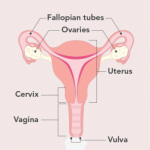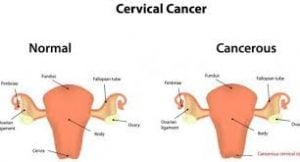
Cervical cancer falls under the ‘Gynaecological cancer’ category. It refers to the cancers that begin in a woman’s reproductive system. The cervix is the lower part of the uterus. The cervix connects the womb or uterus to the vagina. Cervical cancer occurs when the cervix cells overgrow.
What are the signs & symptoms?
- Vaginal bleeding
- Vaginal spotting or discharge
- Pain in vagina
What are the diagnostic tests for cervical cancer?
Colposcopy: It provides a clear look at the inside of the vagina and the cervix. It is a thin tube or colposcope with a lighted camera.
Pap test or Pap smear: It helps scrape off the cervix cells to check them for cancer and pre-cancer.
MRI: The radio waves and strong magnets help make precise images of the affected area. MRI identifies the size of cancer and other tumors in the cervix.
Cervical biopsy: The doctor removes the pieces of the cancerous part of the cervix with a long, hollow needle.
CT scan: It creates detailed images of the body using x-rays. A CT scan detects the spread of cancer outside the cervix.
PET scan: It detects the cancer spread. The doctor puts a small amount of a low-level radioactive substance into the blood. The substance attaches to the cancer cells. A special camera shows any areas of radioactivity.
How advanced is my cervical cancer?

Cervical cancer is classified into stages I, II, III, IV.
Stage I: Cancer spreads from the cervix lining into the deeper and just in the uterus. It has not spread to other body parts. This stage is sub-divided into smaller groups (IA, IA1, IA2, IB1, IB2, IB3) to describe cancer in more detail.
Stage II: Cancer spreads beyond the uterus to nearby areas (vagina or tissue near the cervix), inside the pelvic area. It has not spread to other parts of the body. This stage is sub-divided into smaller groups (IIA, IIA1, IIA2, and IIB) to describe cancer.
Stage III: The tumor penetrates the lower part of the vagina and/or the pelvic wall; and/or regional lymph nodes. There is no distant spread. This stage is sub-divided into smaller groups (IIIA, IIIB, IIIC, IIIC1, IIIC2).
Stage IVA: The cancer spread is up to the bladder or rectum.
Stage IVB: Cancer spreads to other parts of the body.
Ask your doctor about these smaller groups in detail.
What are the suitable treatments for me?
Several kinds of treatment are available for cervical cancer, including surgery, radiation, hormone therapy, immunotherapy, targeted therapy, and chemotherapy.
SURGERY
Surgery helps to cure or control cancer and make symptoms better. It helps to cure cervical cancer if not spread outside the cervix. The standard cervical cancer surgeries are cryosurgery, laser surgery, colonization, and hysterectomy.
The common side effects of breast cancer surgery are pain, nausea, fatigue (tiredness), and anxiety.
Ask the doctor about the kind of surgery suitable for you and what to expect.
RADIATION TREATMENT
Radiation destroys cancer cells left in the cervix after surgery. There are two ways to treat cervical cancer with radiation. The first is by aiming the rays at the cervix from a machine outside the body. The second is by putting radioactive pellets, or tiny seeds, into the vagina near the cervix.
The common side effects are fatigue, diarrhea (dysentery), vomiting (Emesis), and swelling of the genital area.
Most side effects may improve after radiation ends. Ask your doctor about what to expect.
CHEMOTHERAPY
You can take chemo medicines intravenously or orally. The medicines spread through the body via the blood. Chemo is given in cycles or rounds. Each cycle of treatment has a rest time. Chemo is beneficial if cancer has spread outside the cervix.
The common side effects are fatigue, body pain, and hair loss. These side effects go away after chemo treatment ends. If you have side effects, ask your doctor for help.
TARGETED THERAPY
Targeted therapy drugs are helpful for cervical cancer. These drugs majorly affect cancer cells and rarely normal cells.
High blood pressure, fatigue, nausea, heart damage, and blood hematoma (blood clot) are the most common side effects. Talk to your doctor for any help.
IMMUNOTHERAPY
Immunotherapy boosts the immune system to attack the cancer cells. You can administer the drugs intravenously, as a shot, or as pills.
The most common side effects are fatigue, headache, constipation, skin rash, and appetite loss (anorexia).
What are the other treatment options?
The other treatment options may or may not be standard medical treatments. These treatments include vitamins, herbs, and diets. Talk to your doctor about other treatment options.
What to expect after treatment?
You may have fear of cancer recurrence. Visit your doctor every three months after the treatment ends. Do not skip follow-up visits. Your doctors will ask you about new symptoms. A physical examination and diagnostic tests may help to check recurrence.
For the first year, the follow-up visits may be every three months. After the first year, follow-up visits might be every six months, and then at once a year after five years.
Dealing with cancer is challenging. Ankr can help you find the best treatment and cut side effects by half! Sign up for free 30-day trial now (https://my.ankr.us/patientSignup) Ankr is the useful Cancer Platform in and around the USA. It offers the best modern treatment for cancer. Hence, improving the quality and life expectancy of the cancer patients.
